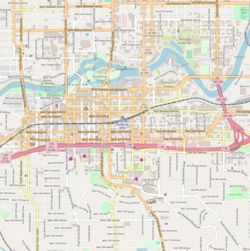Benewah Milk Bottle | |
 The Benewah Milk Bottle was completed in 1935. This structure was one of two in the Spokane area. | |
| Location | S. 321 Cedar St. 802 W. Garland Ave. Spokane, Washington, United States |
|---|---|
| Coordinates | 47°39′10″N117°25′56″W / 47.65278°N 117.43222°W |
| Area | 0.1 acres (0.040 ha) |
| Built | 1935 [1] |
| Built by | W. G. Myers |
| Architect | Whitehouse & Price |
| Architectural style | Novelty architecture |
| NRHP reference No. | 86001521 [2] |
| Added to NRHP | August 13, 1986 |
The Benewah Milk Bottle is a landmark in Spokane, Washington. Listed in the National Register of Historic Places, there are two constructed milk bottle-shaped buildings in the Spokane area, which accompanied a successful dairy operation's stores. One of the buildings is located on South Cedar Street in Downtown Spokane, while the other is located two miles north in the Garland Historical District of North Hill.
Contents
On the morning of September 26, 2011, the Garland Historical District Milk Bottle restaurant, owned by Mary Lou Ritchie, and the historical Ferguson's Café, located next door, were heavily damaged in a fire. Fire investigators believe the fire started in a walkway between the two restaurants. [3]



